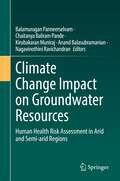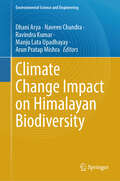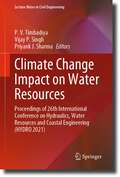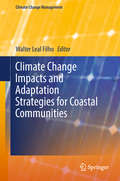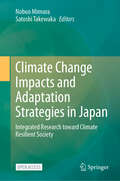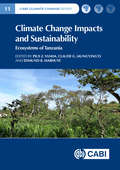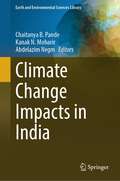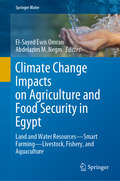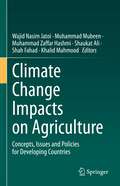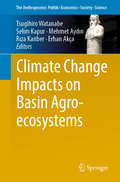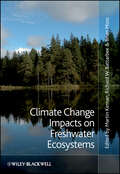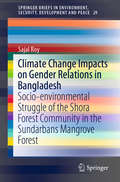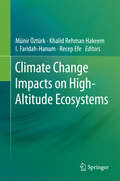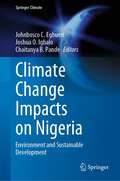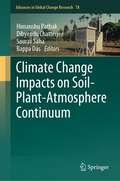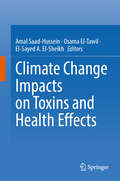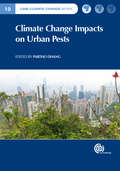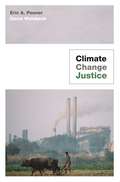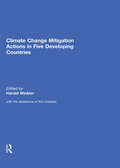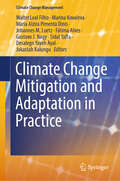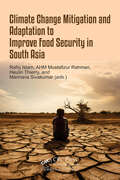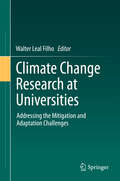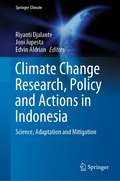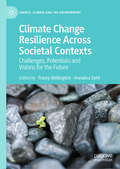- Table View
- List View
Climate Change Impact on Groundwater Resources: Human Health Risk Assessment in Arid and Semi-arid Regions
by Chaitanya Baliram Pande Balamurugan Panneerselvam Kirubakaran Muniraj Anand Balasubramanian Nagavinothini RavichandranThis volume discusses climate change impacts on groundwater quality in arid and semi-arid regions, and provides human health risk assessments due to pollution of surface and groundwater. The book presents recent trends in monitoring groundwater management and implementing pollution mitigation strategies, including practices involving remote sensing and GIS techniques, entropy water quality index, weighted arithmetic water quality index, fuzzy logic applications, and improved irrigation methods. The book also outlines hydrological processes in arid and semi-arid regions and hydrochemical properties of surface and groundwater as a necessary background for understanding how pollution impacts groundwater quality and resources, and how geographical modeling of hydrological processes can aid in human health risk assessments. The book is intended for academics, administrators, policymakers, social scientists, and professionals involved in the various aspects of climate change impact on groundwater quality, hydrological process, pollution mitigation strategies, sustainable development, and environmental planning and management.
Climate Change Impact on Himalayan Biodiversity (Environmental Science and Engineering)
by Ravindra Kumar Naveen Chandra Arun Pratap Mishra Dhani Arya Manju Lata UpadhayayThis book is an informative and profound book that explores the impact of climate change on the unique and delicate environment of the Himalayan region. The book meticulously examines the different plants and animals that live there and how they are affected by changing temperatures and weather patterns. The book showcases how species are changing their habits and distribution patterns and what this means for the future of the Himalayan environment. The book also provides practical suggestions for how local communities and policymakers can work together to protect the region's biodiversity for the future. Overall, this book is an excellent resource for researchers and academics who are interested in learning more about the environmental impacts of climate change on the Himalayan region. The book is written in a clear and accessible manner, making it easy for anyone to understand the profound implications of climate change on this unique and sensitive environment.
Climate Change Impact on Water Resources: Proceedings of 26th International Conference on Hydraulics, Water Resources and Coastal Engineering (HYDRO 2021) (Lecture Notes in Civil Engineering #313)
by Vijay P. Singh P. V. Timbadiya Priyank J. SharmaThis book comprises the proceedings of the 26th International Conference on Hydraulics, Water Resources and Coastal Engineering (HYDRO 2021) focusing on broad spectrum of emerging opportunities and challenges on the impact of climate change on water resources. It covers a range of topics, including, but not limited to, climate change assessment and downscaling issues, climate change impact and adaptive measures, influence of climate variability on hydro-climatic variables, impact of climate change on water resources of Indian Rivers, etc. Presenting recent advances in the form of illustrations, tables, and text, the content offers readers insights for their own research. In addition, the book addresses fundamental concepts and studies on the impact of climate change on water resources, making it a valuable resource for both beginners and researchers wanting to further their understanding of hydraulics, water resources and coastal engineering.
Climate Change Impacts and Adaptation Strategies for Coastal Communities (Climate Change Management)
by Walter Leal FilhoThis book presents a comprehensive overview of research and projects regarding climate change adaptation in coastal areas, providing government and nongovernment bodies with a sound basis to promote climate change adaptation efforts. According to the 5th Assessment Report by the Intergovernmental Panel on Climate Change (IPCC), coastal zones are highly vulnerable to climate change, and climate-driven impacts may be further exacerbated by other human-induced pressures. Apart from sea-level rise, which poses a threat to both human well-being and property, extreme events such as cyclones and storm surges lead not only to significant damage to property and infrastructure, but also to salt water intrusion, groundwater salinisation, and intensified soil erosion, among many other problems. There are also numerous negative impacts on the natural environment and biodiversity, including damage to important wetlands and habitats that safeguard the overall ecological balance, and consequently the provision of ecosystem services and goods on which the livelihoods of millions of people depend. As such, there is a need for a better understanding of how climate change affects coastal areas and communities, and for the identification of processes, methods and tools that can help the countries and communities in coastal areas to adapt and become more resilient. It is against this background that this book has been produced. It includes papers written by scholars, social movements, practitioners and members of governmental agencies, pursuing research and/or executing climate change projects in coastal areas and working with coastal communities. Focusing on "managing climate change in coastal regions", it showcases valuable lessons learned from research and field projects and presents best practices to foster climate change adaptation in coastal areas and communities, which can be implemented elsewhere.
Climate Change Impacts and Adaptation Strategies in Japan: Integrated Research toward Climate Resilient Society
by Nobuo Mimura Satoshi TakewakaThis open access book presents the latest Japanese research for the projection of climate change impacts and the evaluation of adaptation policies, with a particular focus on the S-18 Project—a nationwide, interdisciplinary research initiative involving experts from various fields. Readers can get a comprehensive view of the latest knowledge and strategies to combat climate change impacts in Japan. The topics span the research framework and future scenarios for climatic and socio-economic changes, and impacts and adaptation measures in major sectors at both national and local levels. Target sectors include agriculture, forestry and fisheries, natural ecosystems, natural disasters and coastal zones, water resources, urban infrastructure, and transportation, quality of life and human health, and economic analysis of the impacts. The book features high-resolution spatial distribution of impacts, changes in vulnerability with localities, effects of mitigation and adaptation measures, and implications of climate change policies on society. As the world experiences increased extreme weather events, this comprehensive book is a timely reference for similar studies in other countries through the presentation of research results and lessons obtained in Japan. Researchers, policymakers, and academics in environmental science, climate policy, and related fields will find this book invaluable for understanding and addressing the multifaceted challenges of climate change adaptation and mitigation. Some chapters were written originally in Japanese. The English translation was facilitated by artificial intelligence. The authors later revised the content for accuracy.
Climate Change Impacts and Sustainability: Ecosystems of Tanzania (CABI Climate Change Series)
by Eugen Cyrilo Namkunda Johnson Richard J Katondo Godwin A Lema Emma T Liwenga N A Mbwambo Anselm R Mwajombe Patrick M Ndaki Agnes Ms Nyomora Noah M Pauline Florian Silangwa Kelvine C Shirima Pontian L Temba Adera Sisay Wassie Lucas E Yamat Josephine M ZimbaThis book provides a detailed analysis of the economic and environmental impacts of climate change on the tropical ecosystems in Tanzania. Topics covered include agriculture, marine resources, wildlife, and weather forecasting. The analyses concentrate on real and potential impacts of climate change, focusing on changes in temperature and precipitation. Adaptive capacity and strategies for enhancing resilience (such as changing crop types and crop patterns in farming) are described. Particular attention is paid to climate change impacts on vulnerability and resilience in communities and ecosystems with special reference to extreme events such as droughts and flooding. The book: is among the first books to analyse in detail climate change effects in Tanzania, highlighting the unique vulnerability of communities and ecosystems in East Africa from a socio-ecological point of view. discusses potential future threats as well as providing solutions to current problems. examines the application of local knowledge systems when formulating solutions. The book is essential reading for researchers on climate change and socio-economic impacts in tropical rural economies and of broad interest to climate change scientists, tropical ecologists, conservationists and agricultural scientists.
Climate Change Impacts in India (Earth and Environmental Sciences Library)
by Abdelazim Negm Chaitanya B. Pande Kanak N. MoharirThis book focuses on the impact of climate change on India, addressing environmental problems and conducting an analysis of the climate change impact on mitigation processes. It examines crucial factors such as soil capability, soil erosion, soil salinity, and watershed planning, as well as the influence of climate change on water resources, including groundwater. The book explores the interconnections between climate change, soil erosion, natural resources, and agricultural practices, emphasizing their direct or indirect effects on water, vegetation, irrigation planning, and the environment.Furthermore, it delves into various aspects of soil erosion, soil compaction, soil nutrients, aquifers, and the impact of climate change on vegetation, crops, pests, moisture, and sustainable yield. These factors contribute to the development of climate change-related factors within the agricultural sector, ultimately fostering sustainable development and management practices for the future. The book also highlights the significance of parameters such as land use change analysis, rainfall, water resources, crop yield, sustainable agricultural development, pest management, and disease control in accurately assessing the impact of climate change. The insights gained from these analyses can inform future development and planning strategies. Therefore, this book serves as a valuable resource for researchers, scientists, NGOs, and academics interested in understanding the impact of climate change on natural resources and ecological systems.
Climate Change Impacts on Agriculture and Food Security in Egypt: Land and Water Resources—Smart Farming—Livestock, Fishery, and Aquaculture (Springer Water)
by Abdelazim M. Negm El-Sayed Ewis OmranThis book gathers contributions discussing climate change in Egypt from an agricultural perspective. Written by leading experts, it presents state-of-the-art insights and the latest research developments in light of the most recent IPCC report. Focusing on identifying the specific phenomena that affect climate change in Egypt, the book also addresses the effects of climate change in Egypt, particularly examining the quality and quantity of water resources as well as the socio-economic impacts of climate change on agricultural activities. Furthermore, it explores alternative solutions to support agriculture and food security and raises awareness of adaptation and protection as the key to adapting to the risks posed by climate change. Covering the four fundamental pillars of climate change: food security, availability, access and stability, this book is a valuable resource for stakeholders involved in achieving the 2030 sustainable development goals in Egypt and all countries with similar climatic conditions. It is also a unique source of information and updates on climate change impacts for graduates, researchers, policy planners, and decision-makers.
Climate Change Impacts on Agriculture: Concepts, Issues and Policies for Developing Countries
by Muhammad Zaffar Hashmi Khalid Mahmood Shah Fahad Wajid Nasim Jatoi Muhammad Mubeen Shaukat AliThis book offers perspective on climate change impacts on developing nations from scholars within those nations, primarily focusing on agriculture. Throughout three parts containing a total of over twenty chapters from scholars in developing countries, it aims to offer guidelines for researchers, policymakers, and farmers themselves on how developing countries can achieve sustainable food security and continue development on a sustainable basis.Part I covers climate change concepts and issues for developing countries; Part II offers chapters dealing with social issues surrounding climate change and agriculture; Part III addresses practical policies that can be implemented to work toward achieving the goals described above. Agriculture is a key sector in developing countries in terms of economic growth and social well-being. Adapting and building resilience to climate change means increasing agricultural productivity and incomes and reducing greenhouse gases emissions. This volume represents an effort toward collecting knowledge on the technical, policy and investment measures to achieve sustainable agricultural growth in the sectors of grain, fruit, vegetable, fiber, feed, livestock, fisheries and forest under climate change in one place.
Climate Change Impacts on Basin Agro-ecosystems (The Anthropocene: Politik—Economics—Society—Science #18)
by Selim Kapur Erhan Akça Tsugihiro Watanabe Mehmet Aydın Rıza KanberThis book is based on the outcomes of a Turkish-Japanese bilateral project dealing with the impacts of climate change on basin agro-ecosystems. The book is unique in showing an up-to-date knowledge for the developing world. The chapters are related to: a) the development and improvement of a regional climate model for a more accurate prediction with higher resolution of future changes in regional climate, b) the structure of land and water management in agricultural production systems in arid areas, especially to quantitatively evaluate the relationships among cropping systems, hydrological cycle and water balance in farmland and its environments, c) the assessment of the impact of climate change and its adaptation on agricultural production systems, mainly on the aspect of land and water management, and d) the vulnerability of agricultural production systems from natural changes and the measures for enhancing sustainability of agriculture.This book elaborates on the methodologies for the assessment of climate change impacts on agricultural production and adaptationIn this book, the concepts and processes of an integrated approach are outlined, and its application in a case project is introducedThe approaches described in the chapters would be applicable in different situations and could be improved with experience and the introduction of advanced techniques
Climate Change Impacts on Freshwater Ecosystems
by Martin KernanThis text examines the impact of climate change on freshwater ecosystems, past, present and future. It especially considers the interactions between climate change and other drivers of change including hydromorphological modification, nutrient loading, acid deposition and contamination by toxic substances using evidence from palaeolimnology, time-series analysis, space-for-time substitution, laboratory and field experiments and process modelling. The book evaluates these processes in relation to extreme events, seasonal changes in ecosystems, trends over decadal-scale time periods, mitigation strategies and ecosystem recovery. The book is also concerned with how aspects of hydrophysical, hydrochemical and ecological change can be used as early indicators of climate change in aquatic ecosystems and it addresses the implications of future climate change for freshwater ecosystem management at the catchment scale. This is an ideal book for the scientific research community, but is also accessible to Masters and senior undergraduate students.
Climate Change Impacts on Gender Relations in Bangladesh: Socio-environmental Struggle of the Shora Forest Community in the Sundarbans Mangrove Forest (SpringerBriefs in Environment, Security, Development and Peace #29)
by Sajal RoyThis book explores gendered perceptions of the Sundarbans Forest in Bangladesh, and the extent to which these perceptions are affected by extreme weather events (specifically, cyclones Aila and Sidr). Based on ethnographic fieldwork in Shora, a rural village in southern Satkhira, Bangladesh, the book explores gendered activities in the forest, especially women’s interaction with the forest resources. The findings present a clear picture of the Shora community’s local knowledge about the Sundarbans Forest, as well as the ecological and economic contributions for the forest people. The book makes a timely contribution to the wider study of gender, post-cyclone recovery, ecology and resilience.
Climate Change Impacts on High-Altitude Ecosystems
by Khalid Rehman Hakeem Münir Öztürk I. Faridah-Hanum Recep EfeThis book covers studies on the systematics of plant taxa and will include general vegetational aspects and ecological characteristics of plant life at altitudes above 1000 m. from different parts of the world. This volume also addresses how upcoming climate change scenarios will impact high altitude plant life. It presents case studies from the most important mountainous areas like the Himalayas, Caucasus and South America covering the countries like Malaysia, Sri Lanka, India, Nepal, Pakistan, Kirghizia, Georgia, Russia,Turkey, Indonesia, Malaysia and the Americas. The book will serve as an invaluable resource source undergraduates, graduate students, and researchers.
Climate Change Impacts on Nigeria: Environment and Sustainable Development (Springer Climate)
by Chaitanya B. Pande Johnbosco C. Egbueri Joshua O. IghaloThis book explores the impacts of climate change on Nigeria. How climate change impacts the productivity and future development of different sectors in Nigeria was covered in this book. Various themes of the Nigerian economy, environment, and climate change were considered. Worthy of note are the impacts of climate change on the Nigerian air quality, surface and groundwater resources, watershed and natural resources’ development and planning, soil- quality, fertility, salinization, nutrients and cropping patterns. Also, the impact of climate change on land use/land cover, urbanization and strategic planning, crops and sustainable crop yield; land degradation, soil erosion, landslides and landscapes, rainfall trend patterns, drought vulnerability; ecology, vegetation/forest, carbon and biomass management of Nigeria were investigated. Finally, the problems of climate change in semi-arid and arid regions (with special emphasis on Nigeria) and possible solutions for sustainable development under the changing climate were discussed in this book. Advanced technologies, such as remote sensing, GIS, multivariate analytical tools, and machine learning techniques, were utilized in the exploration and analysis of the themes of this book. Thus, this book is a very important product for point of view researchers, scientists, NGOs, and university communities on the Nigerian climate change. This book is a useful interdisciplinary tool, cutting across various disciplines such as earth sciences, hydrology, environmental sciences, soil science, engineering, remote sensing, natural resources management, and public health management, etc.
Climate Change Impacts on Plant Biomass Growth
by Mohammad AliThis book offers a methodical explanation of our biomass-driven ecosystem, the undeniable uncertainties posed by the response of vegetation to changes in environmental conditions and the fact that humans everywhere have an interest, even an obligation, to cooperate in a global campaign to combat climate change.
Climate Change Impacts on Soil-Plant-Atmosphere Continuum (Advances in Global Change Research #78)
by Himanshu Pathak Dibyendu Chatterjee Saurav Saha Bappa DasThis book explores the interaction between climate change phenomena and the soil–plant–atmosphere continuum (SPAC), which inspects the crucial role of anthropogenic greenhouse gas emissions in modifying the net ecosystem response towards the modified environment. Increasing concentration of anthropogenic greenhouse gases (carbon dioxide, methane and nitrous oxide) from massive deforestation, fossil fuel burning and rapid industrialization in the post-nineteenth century have led to adverse changes in our global climate system. The book evaluates the net impact of climate change on soil, plants and the atmosphere individually and in totality. Among the topics it covers are the impact of climate change on soil environment which encompasses soil processes, nutrient cycling, soil carbon sequestration, soil biota response and soil health management. Also included are the impact on plants with respect to the dry matter assimilation pattern, modification in resource use efficiency, rhizosphere interactions, management of biotic and abiotic stress factors, and regulatory mechanisms of biotic stress factors in modifying the net agroecosystem response towards climate change. Moreover, potential genetic engineering options for establishing C4 or Crassulacean acid metabolism (CAM) in C3 plants, heat–drought stress on pollen biology, breeding ideotype, ecological indicators and crop simulation modelling are considered. Lastly, the impact on the atmosphere takes into account greenhouse gas measurements, mitigation options, eddy covariance measurement of greenhouse gasses, satellite-based monitoring, ecosystem services, abiotic stress management options, air pollution and atmospheric modelling. This book is a valuable resource for researchers, students and policymakers in understanding climate change impacts on interaction processes among the atmosphere, soil and plants from the local to regional scales.
Climate Change Impacts on Toxins and Health Effects
by Amal Saad-Hussein Osama El-Tawil El-Sayed A. El-SheikhThis book covers the impact of global warming on environmental toxins, occupational toxins, food toxins, marine toxins and agricultural toxins. It discusses the current knowledge on the environmental and health effects of these toxins, and how these toxins could be aggravated through global warming and the worsening environmental conditions. Step-by-step, each chapter describes the impact of climate change on a type of the toxins and their health effects, also depicted by numerous photographs and drawings. In addition, clear flow charts aid in identifying the magnitude of the health problem among the target population. Physiology and pathology of these toxins on human body is also discussed. Further topics include the impacts of global warming on drugs and other different therapeutic medications. The book provides an outlook on adaptive measures that could be taken to minimize the toxicity of these toxins, and how to minimize the health impacts. This book assists the medical persons and environmental scientists in negotiating the steep learning curve involved in gaining the skills needed to perform predictive and therapeutic strategies for proper adaptation with climate changes, which offers significant advantages in terms of avoidance of health impact of climate change.
Climate Change Impacts on Urban Pests (CABI Climate Change Series #7)
by David Liszka Roberto Pereira Richard Comont Steven Sims Arthur Appel Chester Moore Carrie Cottone Nan-Yao Su Donald Ewart Lina Nunes Teresa De Troya Magadelina Kutnik Mohamed Sallam Philip Koehler Aleksandra Gliniewicz Grzegorz Karbowiak Ewa Mikulak Marta Supergan-Marwicz Agnieszka Królasik Joanna Myslewicz Tamara Nunes de Lima-Camara Nildimar Alves Honório Eliningaya Kweka Dr Humphrey D. Mazigo Dr Yousif Himeidan Dr Domenica Morona Dr Stephen Munga Dr Ramesh Dhiman Pawel Swietoslawski Dr Martha Macedo De Lima BarataThis book is the first resource to review the influence of climate change on urban and public pests such as mosquitoes, flies, ticks, and wood pests, with respect to population, distribution, disease, damage and control. It systematically addresses how the impact of climate change on pests in urban areas differs from natural areas, focusing on the increased temperatures of urban locations, the effect of natural disasters, the manner of land use and the consequences of human habitation. Climate Change Impacts on Urban Pests: - covers key information on how climate change and urban pests affect human health - includes coverage of the impacts of natural disasters such as flooding looks at issues which could influence the management of pests - explores a range of international opinion from recognised authorities covering six continents. Presenting up-to-date knowledge, this book is an essential resource for researchers in urban pests, entomology and public health, as well as scientists, environmentalists and policy makers involved in studies on climate change.
Climate Change Justice
by Eric A. Posner David WeisbachA provocative contribution to the climate justice debateClimate change and justice are so closely associated that many people take it for granted that a global climate treaty should—indeed, must—directly address both issues together. But, in fact, this would be a serious mistake, one that, by dooming effective international limits on greenhouse gases, would actually make the world's poor and developing nations far worse off. This is the provocative and original argument of Climate Change Justice. Eric Posner and David Weisbach strongly favor both a climate change agreement and efforts to improve economic justice. But they make a powerful case that the best—and possibly only—way to get an effective climate treaty is to exclude measures designed to redistribute wealth or address historical wrongs against underdeveloped countries.In clear language, Climate Change Justice proposes four basic principles for designing the only kind of climate treaty that will work—a forward-looking agreement that requires every country to make greenhouse-gas reductions but still makes every country better off in its own view. This kind of treaty has the best chance of actually controlling climate change and improving the welfare of people around the world.
Climate Change Mitigation Actions in Five Developing Countries
by Harald Winkler with the assistance of Kim CoetzeeFive case studies on mitigation actions (MAs) in developing countries illustrate the rich diversity of climate action. Researchers from Brazil, Chile, Colombia, Peru and South Africa reflect on what is possible in their countries. Case studies reflect the sheer diversity of NAMAs: from a ‘Pronami’ on efficient lighting in Peru, to longer-term challenges of rising energy emissions in Brazil, and much else. The book compares the similarities and differences across eight elements that could assist in developing and implementing mitigation. The comparative analysis highlights both how challenging implementation can be in the context of development, but also points to factors that might enable ambitious mitigation. The comparison suggests that choice of Mas may be linked to institutional capacity, the resources a country is endowed with and hence its emissions profile. International support can be an important global enabler. The authors find that addressing both development and climate objectives is key. This book fills an important gap in the literature from developing country authors about mitigation actions in their own countries. This book was published as a special issue of Climate and Development.
Climate Change Mitigation and Adaptation in Practice (Climate Change Management)
by Walter Leal Filho Marina Kovaleva Fátima Alves Johannes M. Luetz Gustavo J. Nagy Maria Alzira Pimenta Dinis Sidat Yaffa Desalegn Yayeh Ayal Jokastah KalunguThis book is part of the Climate Change Management Series. It includes the works focusing on climate change policies and technologies that support the implementation of climate change mitigation and adaptation strategies. The included works also discuss methodological approaches and experiences showing how the principles of climate change adaptation may be implemented in practice across various geographical regions. The book includes high-quality, interdisciplinary contributions on the scientific, social, economic, political aspects of climate change mitigation and adaptation solutions which makes it available to a wide audience professionals and practitioners.
Climate Change Mitigation and Adaptation to Improve Food Security in South Asia
by Mannava Sivakumar Rafiq Islam Heulin Thierry Ahm Mustafizur RahmanBoth food security and agriculture contribute to, and are affected by, global climate change. The Intergovernmental Panel on Climate Change reports that food production systems account for up to 37% of global greenhouse gas emissions. At the same time, these systems are increasingly vulnerable to climate change, with extreme weather events such as rising temperatures, flooding, drought, secondary salinity, and land degradation threatening food security in South Asia. Additionally, the spread of weeds, pests, and diseases due to shifting climates exacerbates these challenges. The strain on agriculture and food security from accelerated climate change is further worsening by rapid population growth. Globally, more than 820 million people suffer from hunger, and by 2050, food production will need to double to meet global demands. This intensification of farming, combined with climate change, will lead to greater reliance on reactive chemicals, water, and energy inputs—potentially damaging agroecosystem services and becoming increasingly difficult to manage. South Asia, with its high population growth, is particularly vulnerable to climate impacts such as flooding, salinity, droughts, and solar dimming. Rising sea levels and coastal erosion could result in the loss of 17% of land surface and 30% of food production by 2050.Agriculture and food systems must undergo innovative transformations to address these challenges. A comprehensive Climate Change Adaption Framework is essential for fostering a supportive policy environment, sharing information on climate impacts, and adapting climate-smart agriculture to enhance food security in South Asia. This book, based on the outcomes of the 2022 International Conference on Climate Change and Food security in South Asia, held in Dhaka, Bangladesh, explores key challenges and innovative solutions for mitigating and adapting to the impact of climate change on food security.
Climate Change Research at Universities: Addressing the Mitigation and Adaptation Challenges
by Walter Leal FilhoThis unique book provides a multidisciplinary review of current, climate-change research projects at universities around the globe, offering perspectives from all of the natural and social sciences. Numerous universities worldwide pursue state-of-the-art research on climate change, focussing on mitigation of its effects as well as human adaptation to it. However, the 2015 Paris 21st Conference of the Parties of the United Nations Framework Convention on Climate Change (UNFCCC) (COP 21)" demonstrated that there is still much room for improvement in the role played by universities in international negotiations and decision-making on climate change. To date, few scientific meetings have provided multidisciplinary perspectives on climate change in which researchers across the natural and social sciences could come together to exchange research findings and discuss methods relating to climate change mitigation and adaption studies. As a result the published literature has also lacked a broad perspective. This book fills that gap and is of interest to all researchers and policy-makers concerned with global climate change regardless of their area of expertise.
Climate Change Research, Policy and Actions in Indonesia: Science, Adaptation and Mitigation (Springer Climate)
by Joni Jupesta Riyanti Djalante Edvin AldrianThis edited volume reviews the latest advances in policies and actions in understanding the science, impacts and management of climate change in Indonesia. Indonesia is one of the most vulnerable countries to climate change due to its geographical, physical, and social-economic situations. There are many initiatives to understand and deal with the impacts in the country. The national government has issued key guiding policies for climate change. International agencies together with local stakeholders are working on strengthening the capacity in the policy formulations and implement actions to build community resilience. Universities are conducting research on climate change related at different scales. Cities and local governments are implementing innovations in adapting to the impacts of climate change and transiting toward green economy. This book summarizes and discusses the state-of-the-art regarding climate change in Indonesia including adaptation and mitigation measures. The primary readership of the book includes policy makers, scientists and practitioners of climate change actions in Indonesia and other countries facing similar challenges.
Climate Change Resilience Across Societal Contexts: Challenges, Potentials and Visions for the Future (Energy, Climate and the Environment)
by Tracey Skillington Annalisa SettiThis volume sets out to address current gaps in research thinking on how material and non-material factors work in tandem to inhibit effective sustainable development transitions across differing world settings. It will showcase a body of research that accounts for the experiences of cohorts residing in various world regions and provide the reader with a series of conceptual tools with which to understand major factors currently shaping responses to climate change. In that, it responds directly to calls by various international agencies for research communities to provide more detailed evidence of how climate change not only adds to existing societal burdens but also creates newer ones and critically reconsider strategies for realizing UN Sustainable Development Goals in ways that bring SDG 10 on inequalities and SDG 13 on climate action, in particular, together more strategically. With a heavy emphasis on the need for communities to abandon many established socio-cultural practices and adjust comprehensively to a series of new climate imperatives (social, environmental, economic, etc.), little attention is paid to the potential risks these changes pose to the health and wellbeing of vulnerable cohorts. As these risks may constitute considerable barriers to long-term resilience-building and effective climate actions, the difficulties encountered by different communities need to be better understood and accounted for in climate change research. This volume sets out to examine these issues and consider more equitable approaches to climate change resilience-building.
